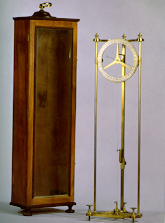
39.6 x 11.2 x 11.9
Wood, steel and brass
CAT. 1824 : L.II.108
Um hygrometro, que Saussure chama grande hygrometro, ou de arvore.
A hygrometer that Saussure called great hygrometer, or tree hygrometer.
It was in the 15th century when it was first observed that wool grows heavier with humidity. Later, Boyle and Goalal observed that the length of a cord from which a body is suspended varied, becoming longer the greater its humidity.
These observations led to the development of absorption hygrometers, of which Saussure's is an example.
The Saussure hygrometer in the Gabinete de Física was constructed in Coimbra. The following inscription can be seen on it, identifying the maker: J. J. Miranda, Coimbra. The apparatus is protected by a wooden box which has a wooden-framed glass door at the front. Its operation was based on the dilation of a strand of hair under tension, when the humidity of the air was increased.
The hygrometer has three vertical shafts, two being cylindrical and the third quadrangular. The cylindrical shafts are in the front part of the apparatus and support a circular ring 8 cm in diameter, on which a scale is engraved. This scale is divided into 360 divisions marked from 0 to 360. Each division is subdivided into 10 parts. Together with the pointer, a horizontal axle installed between the scale ring and the rear shaft, moves. On this axle, next to the face of the dial, is a threaded worm-screw, on which the strand of hair is wound in order to regulate its length.
The tension on the strand of hair can be adjusted through the action of a cord wound on the axle of the pointer. The other end of this cord is fixed on a metallic piece that enters a little cylindrical tube which is narrow inside. This cylindrical tube can move along the vertical shaft of the quadrangle, being placed in a position that keeps the strand of hair under tension.
The hygrometer is calibrated by taking the two extreme situations as a reference: that of saturation by water and that of complete dehydration. For the first case, the hygrometer is placed with a receptacle of water, and covered by a glass bell jar. The dry condition is obtained by putting the apparatus under the bell jar with calcium carbonate or lime.